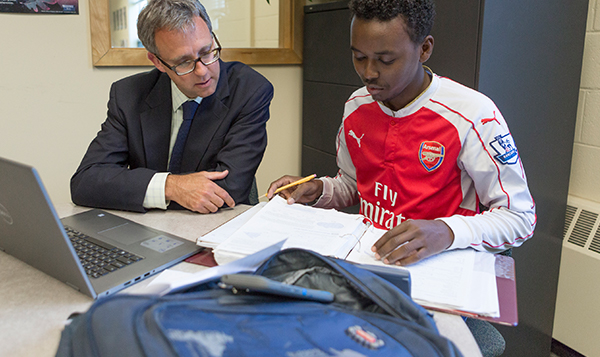Have questions about the FAFSA? Many of the most commonly asked questions are answered below.
Ready to file? Get detailed instructions on our Filing the 2024-2025 FAFSA page.
For more in-depth information on FAFSA Simplification, including recorded presentations, online tools, and helpful resources, please visit our FAFSA Simplification page.
Before You Begin the 2024-2025 FAFSA
What is the FAFSA?
FAFSA stands for Free Application for Federal Student Aid. Filing the FAFSA is the first step in applying for financial aid and is a requirement for students who plan to pay for education after high school with the help of federal, state, or institutional aid such as grants, scholarships, work-study, and loans. The FAFSA typically becomes available each year on October 1st. However, because of the FAFSA Simplification Act passed by Congress in 2020, significant changes were made to the 2024-2025 FAFSA application and processing system. As a result, the 2024-2025 FAFSA was not released until the end of December 2023. Completing and submitting the FAFSA is FREE – be sure to apply at StudentAid.gov.
What is the deadline for filling out the 2024-2025 FAFSA?
Check with all schools you are applying to so you can determine their deadlines. Deadlines to apply for certain types of federal and institutional financial aid vary by school, and many have early deadlines.
To be considered for a Maine State Grant, you must file the FAFSA by May 1, 2024.
Regardless of deadlines, it is best to file the FAFSA as soon as possible after October 1. The earlier you apply, the more financial aid you may be eligible to receive.
What is an FSA ID?
The FSA ID is a Federal Student Aid username and password that you will need to access Federal Student Aid websites, including StudentAid.gov. Your FSA ID is also needed to use the IRS Data Retrieval Tool (DRT) and to sign your FAFSA electronically. If parent information is required on your FAFSA, one parent will also need to create his or her own FSA ID to electronically sign your FAFSA. To create an FSA ID, go to StudentAid.gov and click on “Create Account.” Be sure that you (and your parents, if applicable) have access to your email and/or can receive a text on your mobile phone when creating your FSA ID. In order to create an FSA ID, you must be able to verify that you have access to either your email or mobile phone.
When should I create my FSA ID?
Your FSA ID must be created and matched by the Social Security Administration before you can start your FAFSA, so create your FSA ID early! You can create an FSA ID now at StudentAid.gov.
Keep track of your FSA ID information using FAME’s Students: Create Your Federal Student Aid Account (FSA ID) sheet. Parents should use FAME’s Parents: Create Your Federal Student Aid Account (FSA ID) sheet. Keep these sheets in a secure location — for example, where you keep tax return information.
Will I need to fill out the FAFSA again next year?
Yes. Because eligibility for federal student aid does not carry over from one year to the next, you need to fill out the FAFSA each year you are a student.
Your eligibility for financial aid can differ from year to year for various reasons, including your family’s financial situation.
Where do I find more information about financial aid?
On FAME’s website! Learn about financial aid basics, comparing financial aid offers from different schools, borrowing to pay for college, and more. Use FAME’s Scholarship Search to find scholarships for Maine students. FAME’s PAY: Tips to Afford Higher Education booklet is also available for download.
How to Fill Out the 2024-2025 FAFSA
Is an FSA ID required to access the FAFSA?
Yes! The only way you can access the FAFSA is with your FSA ID. This is also the case for parents and spouses if they are required to provide information on the FAFSA.
Will I need to enter a verification code every time I log into the FAFSA?
Yes, every time you use your FSA ID to access any Federal Student Aid websites, including the FAFSA, you will need to enter a verification code. Depending on the options you set up and verified when creating your FSA ID, you can request that the code be sent via text to your cell phone, sent to your email, or provided by an authenticator app.
If a parent or spouse needs to access the FAFSA, they will need their own FSA ID and will also be required to provide a verification code.
Who is considered a parent on the FAFSA?
If your biological or adoptive parents live together, regardless of marital status or gender, answer the questions about both.
If your biological or adoptive parents are divorced or separated, answer the questions about the parent that provided the majority of your financial support (it does not matter who claimed you on their tax return). If your parent is remarried on the day you file the FAFSA, answer the questions about your parent and your stepparent.
If one of your parents is deceased, answer the questions about the surviving parent. If that parent is remarried on the day you file the FAFSA, answer questions about your parent and your stepparent.
If you live with a foster parent, legal guardian, grandparent, or other relative, they are not considered a parent for the purposes of filing the FAFSA unless that person has legally adopted you. Students in these situations should contact their high school counselor, college financial aid office, or FAME to discuss their situation further and obtain guidance to help them complete their FAFSA.
What if I don’t live with my parents?
If you don’t meet the criteria to be considered an independent student, parent information is needed on your FAFSA.
However, if the situation with your parents is complicated or you do not have contact with either parent, providing information may be difficult or impossible. Consider the following to determine your next steps.
If your high school considers you a homeless student as described in the McKinney Vento Act, you can file the FAFSA as an independent student (no parent information will be needed). You will need to document your situation with the financial aid office. Your high school guidance office can provide you the documentation needed. Please keep original copies of this documentation and only give the financial aid office a copy.
If you are not considered a homeless student by your high school, but do not live with your parent and cannot provide parent information, contact the financial aid office or FAME to discuss your options and determine how to apply for financial aid.
What if my parent doesn’t have a Social Security number?
If your parent doesn’t have a Social Security number, you are still eligible to file the FAFSA. In the parent section, have your parent list his or her Social Security number as 000-00-0000. Your parent should not list his or her taxpayer identification number in that field.
Prior to the 2024-2025 FAFSA, individuals without a Social Security number were unable to create an FSA ID. Starting with the release of the 2024-2025 FAFSA, individuals without a Social Security number will be able to create an FSA ID. The process for creating FSA ID under these circumstances has not yet been defined but we expect to learn more by early fall. We will update the answer to this question at that time.
How do I complete the FAFSA if my parents don’t file a U.S. tax return?
If your parents file a tax return outside the U.S., convert the amounts on the foreign tax return into U.S. dollars and manually enter the information on the FAFSA.
How do I complete the FAFSA if I am homeschooled? Don’t students have to list their high school?
When a student selects “homeschooled” as their high school completion status, the high school question is automatically skipped and not required on the FAFSA.
How do I move through the FAFSA?
Use the “Previous” and “Next” buttons on the bottom of your FAFSA. DO NOT use your browser’s back and forward arrows at the top left of your screen.
Use your “tab” key to move from one question to the next or use your mouse to left-click into an answer field. DO NOT use your “enter” key.
Can I save what I have and come back later?
Yes. You can save what you have and log back into the FAFSA to make changes any time before your FAFSA is submitted.
What year of income information is required on the 2024-2025 FAFSA?
The 2024-2025 FAFSA requires income information from the 2022 tax year.
How will I provide my income and tax information?
When completing the 2024-2025 FAFSA, there will be a check box to grant permission to have your IRS data transferred into the Federal Tax Information module. Your eligibility will be calculated in this module. No tax information will be displayed within the FAFSA.
It is critical that the permission box be checked. If the permission box is not checked, the student will be ineligible for federal aid until a correction is made and the box is checked.
Everyone must check the permission box including those who do not file taxes.
My family’s income is currently less than it was in 2022. Does the FAFSA still require 2022 income information?
Yes, even though the current income is less, 2022 income will still be required on the FAFSA. But, after you file your FAFSA, you will want to follow up with the financial aid office at any school you are applying to attend to let them know about the change in income and discuss a financial aid appeal.
What do I list for income information if I don’t file taxes?
If you work but do not file taxes, use your W-2 form(s) to list income earned from work (salary, tips, and wages).
What are considered assets and what are not?
Assets that must be reported include your current total balance of cash, savings, and checking accounts; college investing accounts; net worth of investments; a family farm or family business; real estate such as rental property, land, and summer homes.
Assets that are NOT reported include the value of your retirement accounts, the home you live in, personal possessions, pensions, and whole life insurance.
How do I get help if I have a question or need help completing my FAFSA?
FAME customer service is available to answer your FAFSA-filing questions Monday through Friday, 8 a.m. to 4:30 p.m. You can call FAME at 1-800-228-3734. You can also email a question to Education@FAMEmaine.com. Emails are answered during business hours. Additionally, we offer individualized Zoom meetings. To schedule a session with one of our financial aid experts, click here. Starting in fall 2023, we will offer sessions to help students and parents create their FSA IDs and file the FAFSA once it becomes available. For a list of sessions, visit our Events page.
Help is also available at StudentAid.gov.
- The help button at the top of each page will redirect you to a list of searchable questions, provide you with information on accessing a FAFSA specialist via live online chat, and provide FAFSA’s email address. If you prefer to speak with someone directly, FAFSA’s toll-free number is 1-800-4-FED-AID (1-800-433-3243).
- The help button is also located next to each question and provides more information about how to answer that question.
After You Complete the 2024-2025 FAFSA
What do I do if I made a mistake on my FAFSA?
Once your FAFSA has been processed (usually about three days), log back into the FAFSA at FAFSA.gov and click on “Edit FAFSA Form.” You can then fix your mistake and resubmit your FAFSA. The updated information will be sent to all the schools listed on the FAFSA.
Do not update your FAFSA to reflect changes that have occurred after the FAFSA was filed. Instead, discuss changes (i.e., changes in income or marital status, but not assets as assets will always reflect that value as of the day the FAFSA was filed) with the financial aid office at your school.
I’ve been selected for verification. Did I do something wrong?
Verification is when the school asks you to verify some of the information you provided on your FAFSA by providing additional documentation and/or by completing a verification form. It DOES NOT mean you did anything wrong! Be sure to provide the requested information to the school as soon as possible.
When will I receive my financial aid offer?
Typically, you won’t receive a financial aid offer until you have completed the financial aid application process and have been admitted to the school. Schools have different schedules for when they send financial aid offers.
What is the best way to understand and compare my financial aid offers?
There is no standard format for financial aid offers, making it difficult to compare offers from different schools. We recommend using FAME’s Comparing Costs & Financial Aid Offers Worksheet to help you understand your offers and get an “apples-to-apples” comparison.
What else can I do to find money for school?
Check out FAME’s Scholarship Search to research scholarships that might be available to you.
What can I do if my financial aid offer isn’t enough?
Schools aren’t always able to meet the full financial need of every student. Start by reviewing your expenses to see if there are ways to reduce your costs. If your financial aid offer is still not enough, consider the options listed on our Financial Aid Offers page under the heading “When the Financial Aid Offer Isn’t Enough.”



